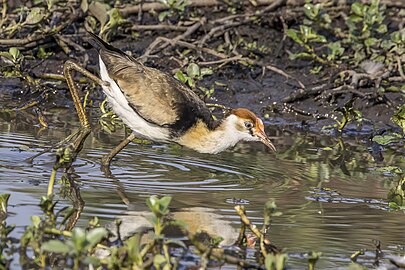Comb-crested jacana
| Comb-crested jacana | |
|---|---|

| |
| Scientific classification | |
| Domain: | Eukaryota |
| Kingdom: | Animalia |
| Phylum: | Chordata |
| Class: | Aves |
| Order: | Charadriiformes |
| Family: | Jacanidae |
| Genus: | Irediparra Mathews, 1911 |
| Species: | I. gallinacea
|
| Binomial name | |
| Irediparra gallinacea (Temminck, 1828)
| |
The comb-crested jacana (Irediparra gallinacea), also known as the lotusbird or lilytrotter (though these names are sometimes used to describe Jacanidae as a whole), is the only species of jacana in the genus Irediparra. Like other jacana species, it is adapted to the floating vegetation of tropical freshwater wetlands.
Description
This species is unmistakable. It has a black crown and hindneck with a fleshy red wattle covering the forehead and forecrown, contrasting with a white face and throat. The comb is pinker in breeding adults, more orange when not breeding.[2] There is a broad black band on the lower breast with white belly. The underwing and flight feathers, which show most prominently in flight, are black. Back and upperwing mainly grey-brown with black primary coverts, rump and tail. The long legs with extremely long toes trail in flight. The male is slightly smaller than the female and measures 20–22 cm (7.9–8.7 in) in length and weighs 68–84 g (2.4–3.0 oz). The female measures 24–27 cm (9.4–10.6 in) in length and weighs 120–150 g (4.2–5.3 oz).[3] The wingspan ranges from 39 to 46 cm (15 to 18 in).
-
Chick
-
Juvenile
-
Adult
Distribution and habitat
The bird occurs in south-eastern
Behaviour
General behaviour
The comb-crested jacana walks slowly and deliberately. It often congregates in flocks. When disturbed, it flies low over water and lands again on open vegetation.
Breeding
The comb-crested jacana is
Feeding
It eats seeds and aquatic insects gleaned from floating vegetation on the water surface.
Voice
This species gives a squeaky, high-pitched chittering, also described as a shrill trill with an explosive soft bugle.[2]
References
- . Retrieved 13 November 2021.
- ^ OCLC 770231941.
- ISBN 978-0-8493-4258-5.
- ^ PMID 11005306
- BirdLife International. (2006). Species factsheet: Irediparra gallinacea. Downloaded from https://web.archive.org/web/20130509230344/http://birdlife.org/ on 10 February 2007
- Marchant, S.; Higgins, P.J.; & Davies, J.N. (eds). (1994). Handbook of Australian, New Zealand and Antarctic Birds. Volume 2: Raptors to Lapwings. Oxford University Press: Melbourne. ISBN 0-19-553069-1
- ISBN 0-207-15348-5




